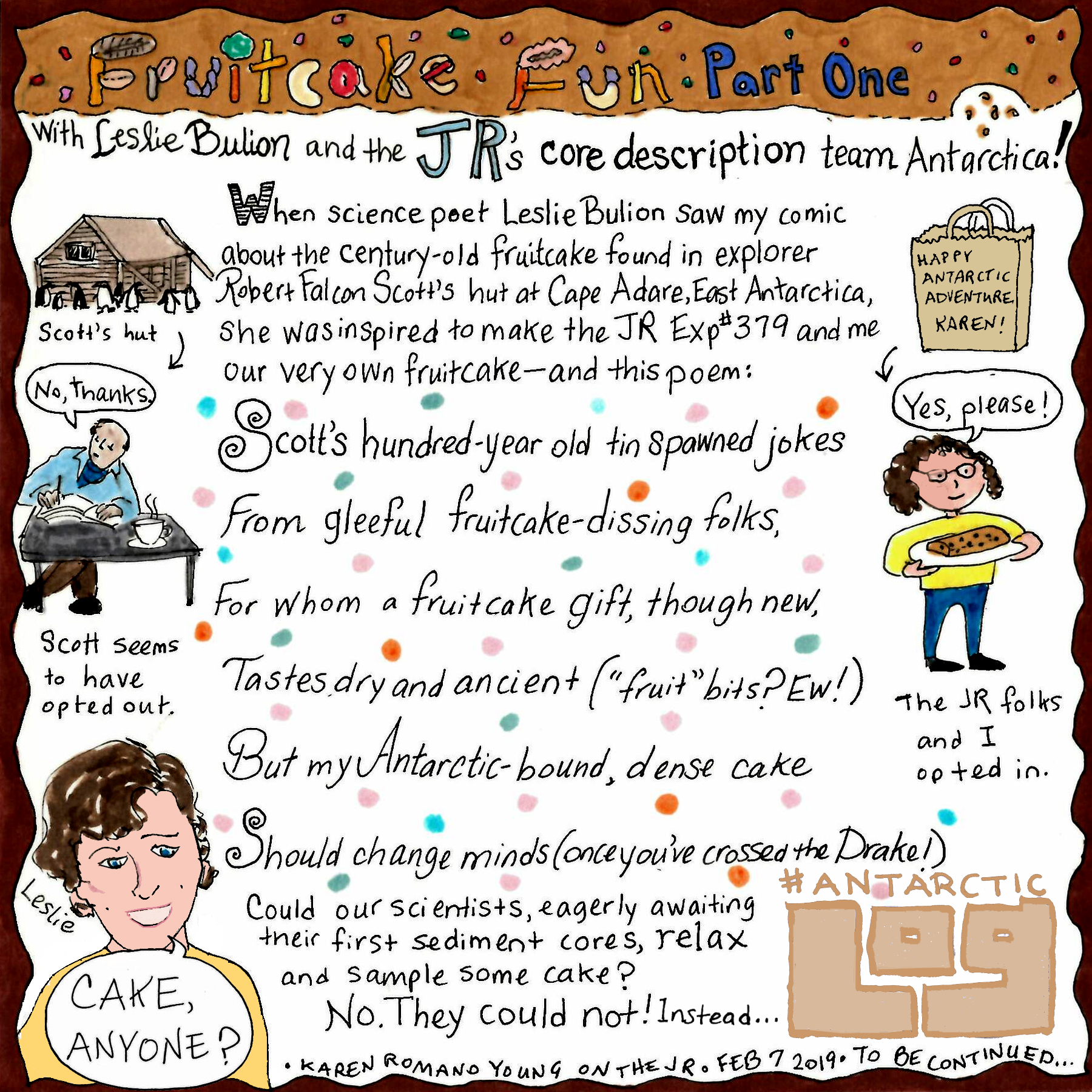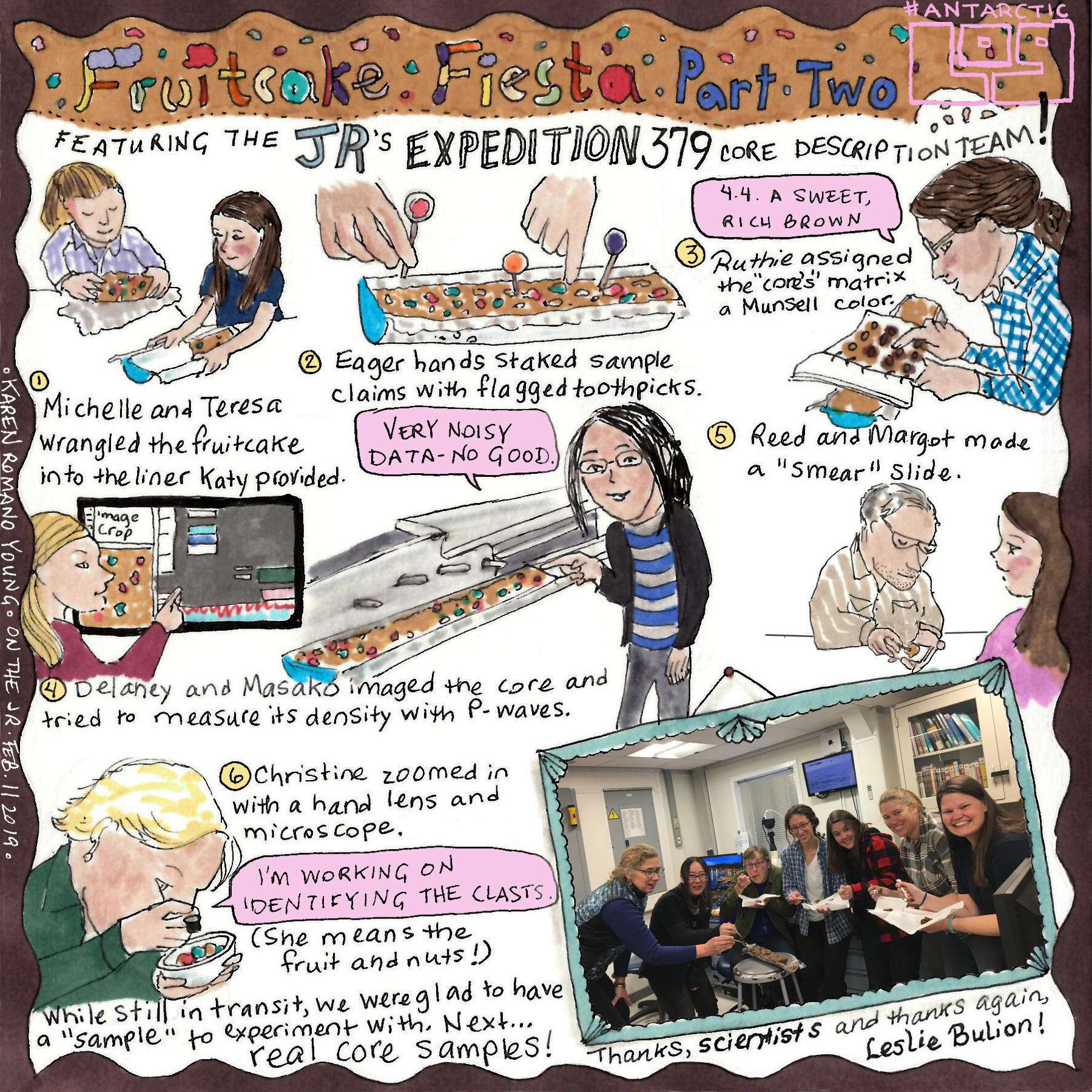27 May 2020
#DrawntoGeoscience: Fruitcake at Sea
Posted by Shane Hanlon
#DrawnToGeoscience is a series of posts by artists who draw about science and explain their process and inspiration while also showcasing their pieces. Learn more about contributing. This week, Karen Romano Young.
I was taking a break last winter from packing to go to sea aboard the JOIDES Resolution for Expedition 379 to Antarctica, scrolling through Twitter, when I saw the story of a fruitcake that had been left behind in 1911 by Sir Robert Falcon Scott’s Terra Nova expedition — and was deemed still edible. I retweeted it because who doesn’t want to read about fruitcake, and the next thing I knew I’d received an incredible, and edible, invitation: the poet Leslie Bulion, a fellow writer, saw the poetry in sending a fresh new fruitcake to Antarctica, and zipped over to put one into my hands, along with a poem about it.
Fast forward to the JR, and me at my drawing table, an outreach officer and artist-at sea, three days out of port and four or five or six more before we reached our first drilling site, in the Amundsen Sea. I was there, in part, to create comics, new installments in the weekly science comic #AntarcticLog I’d begun in 2017. I’d been through all sorts of training about the geoscience that would be taking place aboard the JR as the ship’s drill sucked up sediment cores from below the seafloor — cores containing materials that had rained down in sequence so that, like the rings on a tree, they conveyed the conditions of the times in which they’d fallen. I’d toured the labs where the core would be described in a multitude of ways, with a careful eye both to establishing its place on the geological timeline, and to analyzing it to show what lived there under what conditions and due to what events.
We were all ready to go, with nothing to do but hurry up and wait. For me — not part of the science team — there was a bit of pressure to get to know people, instruments, and processes before the first joyous shout of “CORE ON DECK” rang out. I knew what to do: I had fruitcake!
I tucked Leslie’s foil and plastic wrapped brick of cake under my arm and headed up to the core description lab. I carefully divided the fruitcake, slicing it an inch thick and being prepared to cube it to get a bit to everyone in the lab. Well, if there’s one thing I’ve learned about scientists — if you give them an inch, they’ll take it a mile. Today was no exception. Or maybe I should say this week. Because I didn’t just get one comic out of the situation, I got three. Here they are.

You can see what the story is from the comics included here: the core description labbers decided to use Leslie’s fruitcake to practice analyzing cores. They stopped me from slicing the cake, and stuffed it instead into one of the clear, rigid liners in which core comes up, like noodles. They hunched over the pecans and raisins, the green-dyed cherries and — I don’t know what the red things were, red cherries?
 They imaged the core, and measured its density with P-waves, pronouncing it “noisy.” They staked out sample claims, and identified the “clasts”—such as weird cherries — looking through a hand lens. They assigned the fruitcake a Munsell color. They made a smear slide, and examined it under the microscope. And they used it to establish how they’d use core to tell the story of the history of the Amundsen Sea basin, into which the Thwaites Glacier, among others, flows.
They imaged the core, and measured its density with P-waves, pronouncing it “noisy.” They staked out sample claims, and identified the “clasts”—such as weird cherries — looking through a hand lens. They assigned the fruitcake a Munsell color. They made a smear slide, and examined it under the microscope. And they used it to establish how they’d use core to tell the story of the history of the Amundsen Sea basin, into which the Thwaites Glacier, among others, flows.
 And as they did, they distinguished themselves one from the other, no more a clump of people I knew only by name, and clarified their roles — while getting to know the lab, too. And, thank goodness, so did I: in that week at sea, in between scanning the horizon for the first icebergs, I got to know people and procedure. What’s more, as the comics came out, so did our public. Leslie’s poem even debuted — more proof, if we needed it, of the value of the arts in the sciences.
And as they did, they distinguished themselves one from the other, no more a clump of people I knew only by name, and clarified their roles — while getting to know the lab, too. And, thank goodness, so did I: in that week at sea, in between scanning the horizon for the first icebergs, I got to know people and procedure. What’s more, as the comics came out, so did our public. Leslie’s poem even debuted — more proof, if we needed it, of the value of the arts in the sciences.
–Karen Romano Young is a writer, artist, deep-sea diver, and polar explorer. Follow her on Twitter & Instagram.


 The Plainspoken Scientist is the science communication blog of AGU’s Sharing Science program. With this blog, we wish to showcase creative and effective science communication via multiple mediums and modes.
The Plainspoken Scientist is the science communication blog of AGU’s Sharing Science program. With this blog, we wish to showcase creative and effective science communication via multiple mediums and modes.